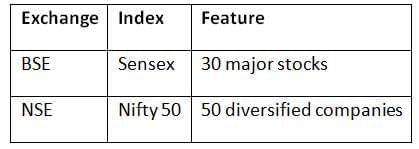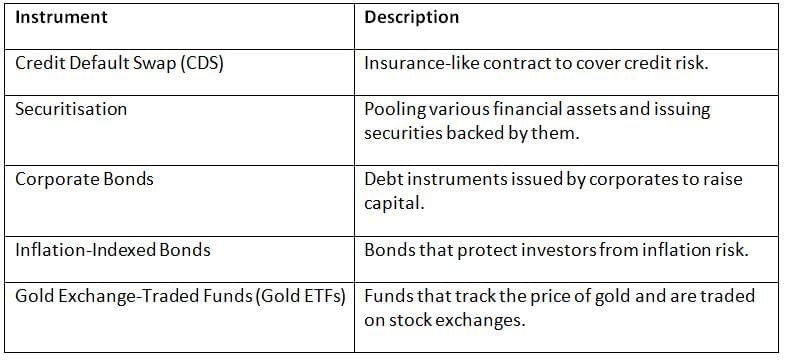UPSC Exam > UPSC Notes > Indian Economy for UPSC CSE > Cheat Sheet: Security Market in India
Cheat Sheet: Security Market in India | Indian Economy for UPSC CSE PDF Download
Introduction
The securities market in India facilitates the buying and selling of financial instruments like shares, bonds, debentures, derivatives, etc.
It is broadly divided into:
- Primary Market (new securities are issued)
- Secondary Market (existing securities are traded)
Stock Exchanges in India
Key Stock Exchanges:
- NSE (National Stock Exchange) – Largest exchange by volume.
- BSE (Bombay Stock Exchange) – Asia’s oldest stock exchange.
Other platforms: Metropolitan Stock Exchange, Calcutta Stock Exchange, etc.

Primary Market
Where companies issue securities for the first time (IPO).
Key mechanisms:
- Initial Public Offering (IPO)
- Follow-on Public Offering (FPO)
- Private Placement
- Rights Issue
IPO (Initial Public Offering)
- First-time offer of equity shares to the public.
- Regulated by SEBI.
- Needs to follow the Book Building Process or Fixed Price Method.
Secondary Market
- Investors buy/sell already issued securities.
- Trades are carried out through stock exchanges.
- Clearing and settlement are done via institutions like NSDL, CDSL, and CCIL.
Regulatory Body: SEBI (Securities and Exchange Board of India)
Established: 1988 (Statutory in 1992).
Functions:
- Protect investor interests.
- Regulate and develop capital markets.
- Approve mutual funds, brokers, and IPOs.
Mutual Funds
Investment vehicle that pools money from investors and invests in diversified assets.
Types:
- Equity Funds
- Debt Funds
- Hybrid Funds
- Index Funds
Commodity Trading and Spot Exchanges
Commodity Exchanges:
- MCX (Multi Commodity Exchange)
- NCDEX (National Commodity & Derivatives Exchange)
Spot exchanges allow immediate delivery and settlement of commodities.
Foreign Financial Investment
- FDI (Foreign Direct Investment) vs FPI (Foreign Portfolio Investment)
- Qualified Foreign Investors (QFIs): Allowed to invest directly in Indian equity markets.
- Participatory Notes (P-Notes): Derivative instruments issued by registered FII to overseas investors.
Modern Financial Instruments

Reforms & Challenges
- Digitisation and dematerialisation of shares.
- Introduction of T+1 settlement (Trade plus one day).
- Increased foreign participation.
- Challenges: Volatility, investor awareness, regulatory complexity.
Key Developments
- SEBI introduced new framework for ESG (Environment, Social, Governance) ratings.
- Stringent rules for IPO pricing transparency.
- Push for retail participation via online trading platforms.
- India's bond market being integrated with global indices (e.g., JP Morgan GBI-EM inclusion expected by 2025-end).
The document Cheat Sheet: Security Market in India | Indian Economy for UPSC CSE is a part of the UPSC Course Indian Economy for UPSC CSE.
All you need of UPSC at this link: UPSC
|
151 videos|488 docs|159 tests
|
FAQs on Cheat Sheet: Security Market in India - Indian Economy for UPSC CSE
| 1. What are the main functions of stock exchanges in India? |  |
Ans. Stock exchanges in India serve several vital functions including providing a platform for buying and selling securities, facilitating price discovery through supply and demand, ensuring liquidity for investors, offering a mechanism for raising capital through Initial Public Offerings (IPOs), and providing a regulated environment that enhances investor confidence.
| 2. What is the difference between the primary market and the secondary market? |  |
Ans. The primary market is where new securities are issued and sold for the first time, allowing companies to raise capital directly from investors. In contrast, the secondary market is where previously issued securities are traded among investors, providing liquidity and the opportunity for price adjustments based on market conditions.
| 3. How does SEBI regulate the securities market in India? |  |
Ans. The Securities and Exchange Board of India (SEBI) regulates the securities market by framing regulations for market participants, monitoring trading activities, protecting the interests of investors, promoting fair practices, and ensuring transparency. SEBI also oversees the functioning of stock exchanges and mutual funds to maintain market integrity.
| 4. What role do mutual funds play in the Indian financial market? |  |
Ans. Mutual funds collect money from various investors to create a diversified portfolio of stocks, bonds, or other securities. They provide investors with professional management, diversification, and liquidity while allowing them to invest in a range of assets according to their risk tolerance and financial goals.
| 5. What are the key features of commodity trading in India? |  |
Ans. Commodity trading in India involves the buying and selling of physical goods such as metals, agricultural products, and energy resources. Key features include regulated exchanges, futures and options contracts, price discovery mechanisms, and the ability for investors to hedge against price fluctuations. Spot exchanges are also available for immediate delivery transactions.
Related Searches
















